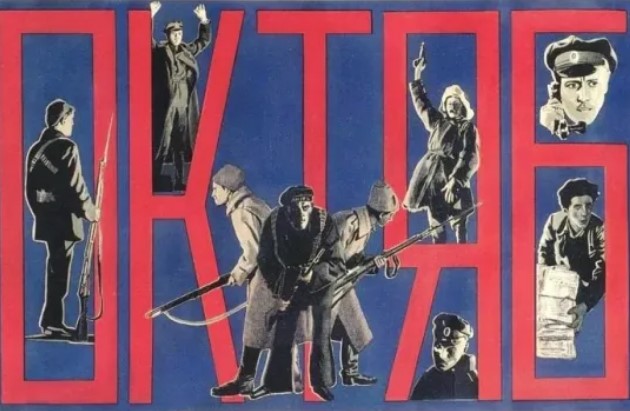The Russian Revolution ushered in a flowering of creative expression in all the arts, but particularly cinema, which was advanced to new heights by the likes of Dziga Vertov and Sergei Eisenstein, who regarded film as a weapon of class struggle. Despite being cut short by the Stalinist degeneration of the regime, the legacy of October in the field of filmmaking continues to be felt to this day.
Read the original in Spanish here |
The Russian Revolution of 1917 was the greatest transformation mankind has yet undergone. This transformation had to contend with a colossal cultural lag: the Russian masses lived under enormous exploitation and cultural underdevelopment. 80 percent of people between 8 and 50 years old were illiterate; and in Central Asia, many languages did not even have a written alphabet. Deep economic hardship from the early years of the revolution accompanied this legacy of immense cultural backwardness.
The revolution was not able to prioritise art in its early years, and yet from the outset, it sought to bring the masses out of their state of backwardness, starting with education. Children with empty stomachs went to school for the first time, although those schools were unfurnished, and every five schoolchildren had to share a pencil between them. The revolution attracted the best of the intelligentsia, with the youth at the forefront.
In these conditions, a galaxy of artists and talented individuals flourished, and society took advantage of this. There were radical new advancements in every artistic discipline. Cinema, which achieved little development under tsarism, would rise to great heights.
Soviet montage: the Russian Revolution’s contribution to cinema
Tsarism and capitalism had been done away with, and there was an atmosphere of freedom in the streets that was reflected by artists and their work. Under a working-class government, Russia created the world’s first film school. At times, funds did not even extend far enough to buy film stock. Nevertheless, filmmaker and cinema scholar Lev Kuleshov was able to make his initial contributions to the development of ‘montage’ through his experimentation with stock footage. Vsevolod Pudovkin, a contemporary of Sergei Eisenstein and director of many acclaimed revolutionary films, was Kuleshov’s most notable student and follower. Nowadays, it is common in cinema to speak of the Kuleshov effect.
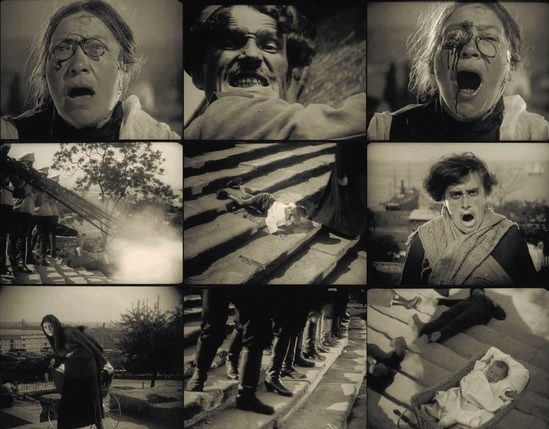 Montage examples from the Odessa steps scene in Eisenstein's Battleship Potemkin / Image: Fair Use
Montage examples from the Odessa steps scene in Eisenstein's Battleship Potemkin / Image: Fair Use
Prior to Kuleshov’s experiments, cinematic editing had developed into a language, albeit in a linear direction. But Soviet montage, the great contribution of the Russian Revolution, represented a revolutionary development that has remained fundamental to cinema up to the present day. It involves the arrangement of various shots which, although supposedly unrelated to each other, represent an idea and generate a certain dramatic effect when combined in a specific way.
For instance, if we take a close-up of a serious person and another shot of the same person smiling, we can insert a different shot between them; for example, of a young person descending from a train, or a sleeping baby, or some workers placing red banners on a factory entrance. The combination of images in each scenario will communicate an entirely different message and effect on the viewer.
Soviet montage owes as much to Dziga Vertov and his Kino-Pravda (Film Truth) newsreels; and the cinema of Sergei Eisenstein, who would build upon Kuleshov’s discoveries. During the civil war years, the Red Army created an ideal breeding ground for cinema. In addition to waging war with guns and grenades at the battlefront, they waged war with the movie camera. The imperialists conducted a propaganda campaign, with documentaries and reports attacking the communists; and the revolution responded. A group of cameramen called kinoks would risk their lives to film scenes from the battlefield. Their slogan was: “film or die”. Dziga Vertov received this material from several active fronts, and used them for his Kino-Pravda stories, further developing the montage technique.
Lenin, Trotsky and cinema
In 1922, Lenin said: “For us, cinema is the most important of all the arts. Cinema must be and shall be the main instrument of the proletariat.” Another time, he would say: “If bread serves to feed the body, film and the dramatic arts must become food for the spirit, as the people have the right to an art form, the essence of which is the constant search of truth and beauty.” (La vanguardia cinematográfica sovietica (1918-1935), Vega Alfaro, E., 2000, pp.15-16)
Trotsky would agree with his judgement and pointed out that:
“The most important weapon in this respect [in terms of the means of entertainment and collective education], a weapon excelling any other, is at present the cinema. This amazing spectacular innovation has cut into human life with a successful rapidity never experienced in the past.”
(Trotsky, L., Problems of Everyday Life, 2000, p.32).
Amidst the struggle against cultural backwardness and imperialism, cinema was an important tool of the proletarian revolution. Painted trains with rooms converted into cinemas were used to tour the country. Cinema and other forms of artistic expressions such as posters and theatre played a role in the propaganda. But aside from this important political function, in the early years of the revolution, this art would be made in an environment of great freedom.
Eisenstein: the greatest Soviet filmmaker
Eisenstein is the most important filmmaker to emerge from the October Revolution. His masterpiece, Battleship Potemkin, is one of the greatest works ever committed to film. Revolutionary Russia, which had inherited substantial underdevelopment, demonstrated to the world that it was able to achieve colossal feats, not only in its economy, but also in art.
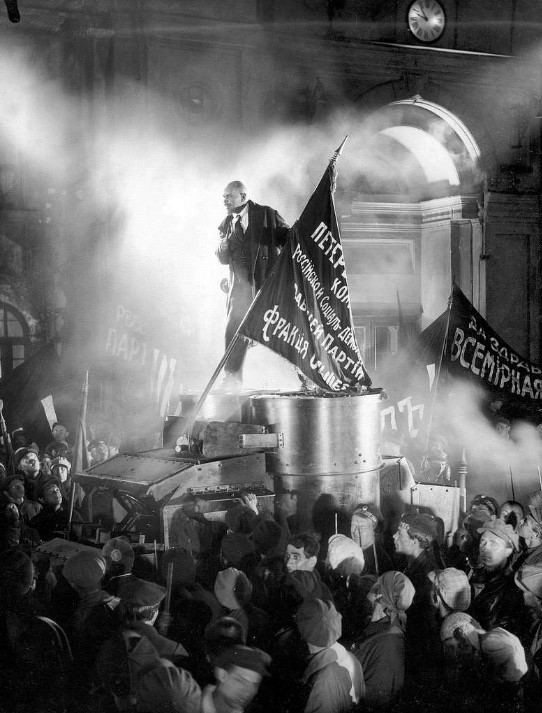 A still from Eisenstein's 1928 film October: Ten Days That Shook the World / Image: Public Domain
A still from Eisenstein's 1928 film October: Ten Days That Shook the World / Image: Public Domain
Eisenstein made a film about the October Revolution, October: Ten Days That Shook the World (1928), in which references to Trotsky were featured heavily. Under bureaucratic pressure, he had to make changes, although he did not completely remove these references from the film.
Trotsky stated that it was not the role of the party to determine the content of art. Lenin also maintained a position of preserving complete artistic freedom. This did not extend to practical action against the revolution, which was not the same matter; in this case, the revolution had the legitimate right to defend itself. Yet the rise of bureaucracy curbed artistic freedom in general.
The rise of Stalinism
The great misfortune of art and Soviet cinema is that, just when they started to flourish, bureaucratic counterrevolution in the form of Stalinism began. It first crushed the vanguard of early Soviet art, as was the case with the suprematist and constructivist schools. Socialist realism, which was in fact neither realist nor socialist, was made the official Soviet art style. Bureaucracy spurns the revolution. It is not interested in revolutionary art, but rather simple art, reflecting its narrow outlook. If many artists used their talents in service of the revolution before, now the bureaucracy dictated what they had to say.
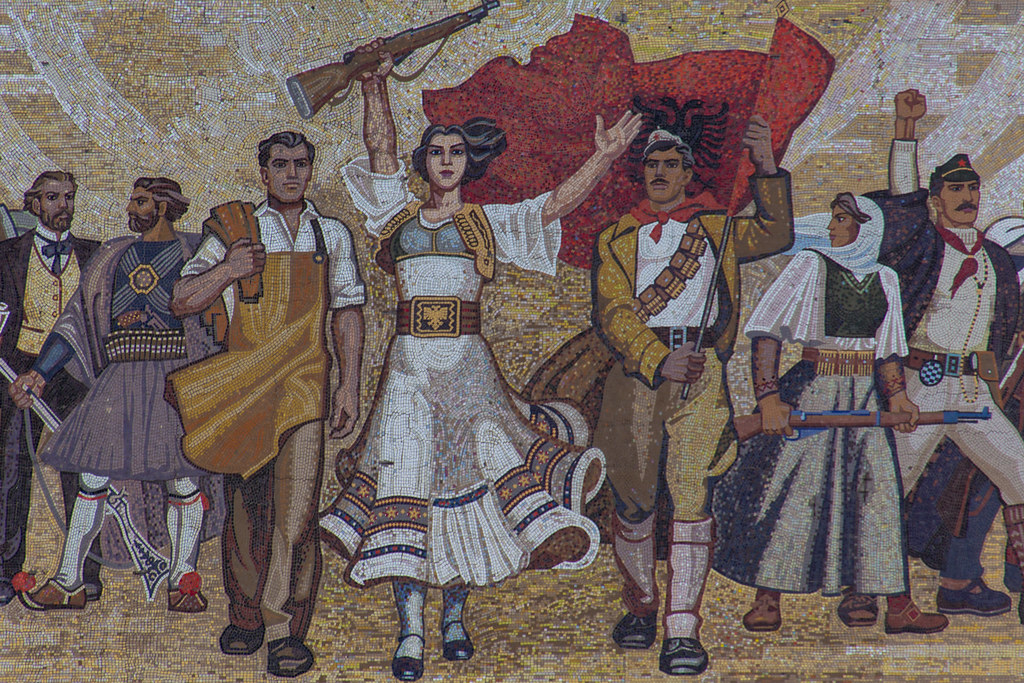 Socialist realism was a style of art which represented life in the USSR, 'communist values', and the role of the bureaucracy in an idealised, simplistic and ossified way. It was made the official style of the USSR in 1932 and rigidly enforced / Image: Marcel Oosterwijk
Socialist realism was a style of art which represented life in the USSR, 'communist values', and the role of the bureaucracy in an idealised, simplistic and ossified way. It was made the official style of the USSR in 1932 and rigidly enforced / Image: Marcel Oosterwijk
Geniuses such as Eisenstein would be censored. He was obligated to make films according to the norms of socialist realism. Even then, he cast scathing commentary on the bureaucracy, which would remain in his final films.
Eisenstein’s clashes with the capitalist film industry
Eisenstein wanted to be free from the chokehold of bureaucracy. He travelled abroad, but he did not achieve success there. He was reviled as a communist filmmaker. In Europe, there was no one who wanted to invest into making a feature-length film with him. He only managed to make a couple of short films, one of which was Misery and Fortune of Woman (1929) — a film with great class content about the woman’s right to abortion in Switzerland.
He eventually arrived in Hollywood, but he could not film anything. This is scarcely surprising, as he wanted to make a film there about Marx’s Das Capital, and his ideas on cinematography were in and of themselves revolutionary. In the U.S. he said:
“Imagine a cinema which is not dominated by the dollar. A cinema industry where one man's pocket is not filled at other people's expense; which is not for the pockets of two or three people but for the heads and hearts of 150 million people. Every motion picture affects heads and hearts, but as a rule motion pictures are not produced especially for heads and hearts. Generally motion pictures are turned out for the benefit of two or three pockets; only incidentally do they affect the heads and hearts of millions.” (Sergei M. Eisenstein, The definitive biography, Marie Seton, 1960, p.159).
In Mexico, he began but failed to complete ¡Que viva México!, a film which highlighted Mexican culture, and explored the dialectic between life and death. This unfinished film vindicated, and criticised the limits imposed upon working women and the exploited. It also criticised the limits of the Mexican Revolution, which had not put an end to capitalism.
This film was financed by the socialist writer Upton Sinclair. The associated cost was high, and production was plagued by crisis. Stalin sent letters that influenced Sinclair to end the filming. The recordings were taken from Eisenstein and he was never able to edit them.
The Soviet director could not make a single feature-length film in the capitalist countries. Eisenstein is an eminent product of the October Revolution. His ideas on politics and film did not fit the mould of capitalist film productions, nor did they fit into Stalinism.
Alexander Medvedkin and his film train
When Eisenstein returned to the USSR in 1932, the bureaucratic machine at the time enjoyed great power. But even in that period we saw a glorious era of Soviet cinema. An old general of the Red Army named Alexander Medvedkin wanted to abandon his military career to make films. His decision was not an act of political surrender. The Central Committee of the Communist Party approved the decision to grant him a film train, but afterwards he did not have much control exerted over him.
Medvedkin and his group of artistic collaborations went out amongst the people with the slogan “film today, screen it tomorrow”. They went into factories to witness and document the real issues affecting working people.
The actors in these films were the townspeople and factory workers, and people went to see them out of curiosity. However, upon seeing the content of these productions, where the Stalinist bureaucrats would be criticised, political meetings usually followed. Decrees and orders in favour of the workers were agreed on and local bureaucrats were dismissed from the workplaces. In some factories, this led to the establishment of workers’ control over the factories’ administration.
Commenting on one of these films, How are you doing, fellow miner? (1932), Medvedkin stated:
“Any attempt to provide food to the miners was attacked with utter bluntness and audacity. Here an enormous factory kitchen fed the miners so badly that they stopped coming to the canteen. Everything seemed bland, everything was filmed honestly, everything was rough… The company was led by a bunch of crafty devils. They knew how to persuade the administration, with money in their hands, that everything was due to a lack of supply. (Medvedkin, A. (1973) El cine como propaganda política, p. 10)
The crew members of the film train were not petit-bourgeois artists looking for adventure. They were Bolsheviks committed to the struggle for socialism and against bureaucracy, despite the latter’s efforts to extinguish the traditions of the October Revolution. They had to bear many assassinations. Artists fell victim to the purges. To the misfortune of the filmmakers, Stalin liked cinema and would personally watch all their films.
Under socialism, we will see art flourish to its fullest potential!
Nowadays, our lives are full of images. The field of battle might look different as far as filmmaking is concerned, but it continues to be a battleground for the class struggle. The lessons of the Russian Revolution can help us to more effectively communicate our ideas, and envision how revolutionary developments will push the arts forward.
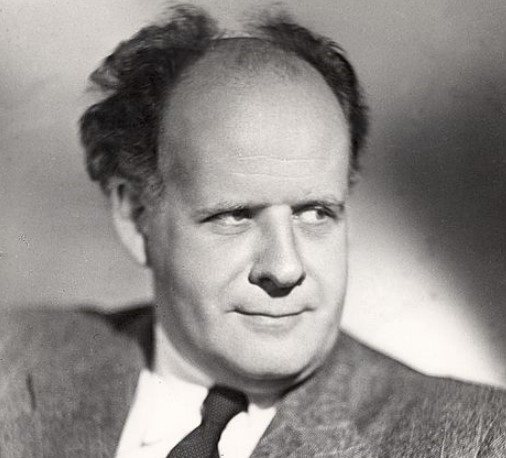 Eisenstein wrote that art "is not a pacifistic medium: it is a fighting force" / Image: Public Domain
Eisenstein wrote that art "is not a pacifistic medium: it is a fighting force" / Image: Public Domain
The Russian Revolution awakened the best of society. It allowed for an explosion of talent. One of its achievements was montage, which remains prominent in cinematic expression around the world. Stalinism could not take that away.
Art does not need to propagandise, nor must it be partisan, but the Russian Revolution also gave us examples of art that was committed, in many senses, to the revolution. The explosive awakening of Soviet art in its initial years is irrefutable evidence of the potential that will be unlocked by a future socialist society. Under socialism, we will see art flourish to its fullest extent, never seen before by mankind.
Eisenstein expressed fierce criticism of Stalin in his final films. When Stalin was watching his last film, the Soviet director felt so much tension that he went into cardiac arrest and died soon afterwards. While hospitalised, he wrote the following in his memoirs:
“But the originality of our cinema does not lie only in its form, scope, or method. Form, scope and method— these are merely the result of the basic peculiarity of our cinema. It is not a pacifistic medium: it is a fighting force. Our cinema is a weapon, first and foremost, to be used for combating hostile ideology; and primarily it is a tool whose principal task is to influence and recreate.” (Eisenstein, S. Volume IV: Beyond the Stars, The Memoirs of Sergei Eisenstein, 1995, p. 25)

